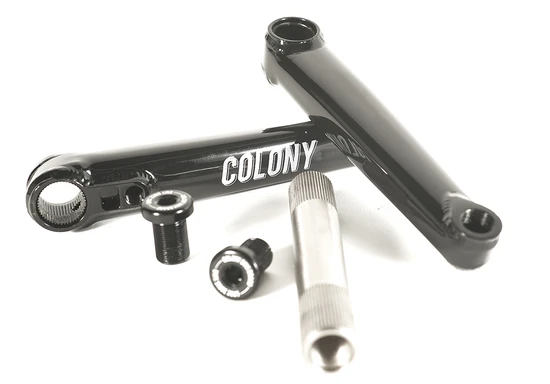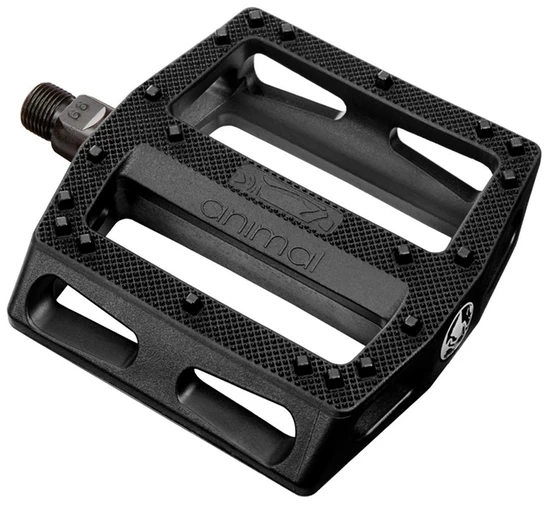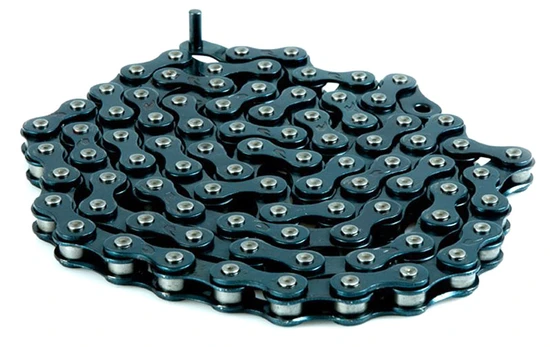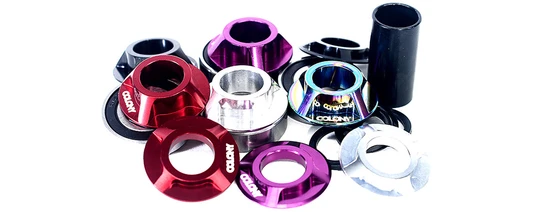BMX Cranks, Sprockets, Pedals, Chains & Bottom Brackets For Sale
Bmx Australia is selling BMX Cranks, Sprockets, Pedals, Chains & Bottom Brackets. View our store below and view our guide below to know whats best for your BMX bike.
SHOP HERE:
BMX Cranks
BMX bike crank might seem a bit technical considering its parts and other features. Therefore, we have created this comprehensive guide to help you fully understand all aspects of the crank so that you can make an informed decision.
Different types of crank materials
A crank can be made from one of the five materials. They are regular steel, Chromoly Steel, Aluminum Alloy, Carbon Fibre, and Titanium. However, among all these materials, the Aluminum alloy is the most common of all.
The reason for the popularity of this material is that it provides strength and is a lightweight BMX crank.
3 piece crank vs. 1 piece crank
We discussed above how Aluminum is a common material used for a crank as it provides strength. Apart from the material, the type of crank also plays a role in how strong it will be.
For example, 3 pieces of cranks are stronger than 1 piece because they use good quality racing speed, bearings, and spindles, among other things. If you plan to use your bike on rough terrain, a 3 piece crank BMX will give you peace of mind.
Searching for BMX cranks/cranksets into the market is a tedious and challenging task because many of the information and statistics of the cranks can be lost in translation. However, in this guide, we show important factors that you should find out before making your purchase that will allow you to make the perfect decision.
How to choose BMX cranks:
Crank is an integral part of a bike. Without a good quality of Crankset, none can get comfort and smoothly pedaling feelings. Usually, cranks are the metal arms that attached you’r pedals to your Bottom bracket, a set of cups and bearings that are inside your frame.
Cracks are a serious hit from grinds, stalls, hard landings, or wearing straight up wear and tear, so they need to be tightened. Cranks come in almost every color you can imagine, allow for some personalisation, and are a great place to save weight.
BMX Crank’s help creates smooth pedal strokes and depending on your riding style, and you may need a stronger crankset than someone who fights with your BMX who wants a lightweight crankset
BMX Sprockets
How do Sprocket Gear Ratios Work?
Gear ratios have a lot to do with the concept of a circumference of a circle. When two gears are interlocked with each other
Bicycles differ the difficulty of rotation via the gear ratio of the sprocket and gears. Think about the gears on a mountain bike. MTB’s can have up to the chainrings at the front, the biggest of which gives you the hardest time pedalling.
On the back, a bike can have up to 12 gears, this time the smallest of which requires the hardest effort to pedal. Having the maximum gears on the front and back of a bike will give you a whopping 36 gears to go at.
What Size Sprocket Should I use for BMX?
On a BMX you don’t have the flexibility as a mountain bike. You need to test and pick a gear ratio and sprocket size that fits your riding style and stick with it.
When I say ‘stick with it’ I don’t mean forever. Just until you can be bothered to take everything apart and change it over. This can be a pain and you won’t want to do it before every ride.
Most Intermediate and advanced BMX bike will be built with a 25T/9T or 28T/9T ratio. This means the front sprocket will have 28 teeth while the back one will have 9.
Having 8 or 9 teeth on your rear chainring is pretty common and doesn’t usually change much. They’re already quite small and hard to remove so most people stick with altering the size of their sprocket.
Most beginner or intermediate riders will be perfectly fine with a 25T or 28T sprocket. If you do want to change things up then you need to think about the type of riding you will be doing.
Dirt jump riders require more speed and normally have a nice drop-in so a larger sprocket could work well. Maybe 30T or 32T.
On the other hand, someone who rides flatland and needs the ability to transfer power to the wheels quickly without worrying about speed might benefit from a slightly smaller sprocket.
Generally, the sprocket is just a one-piece attaches to the chain to improve efficiency and speed. However, while buying a sprocket you must drill into few fair things. These attributes can sway your choice from one or another way. The design and number of teeth in a sprocket are important factors to look into while buying but there are few other things you should recheck such as bash guard and spline or bolt drive before you make a final purchase.
So at the end of the day, it’s you that took the decision. The market has been filled up with a large number of sprockets and each holds different benefits and other properties based upon the riding style you are riding. Hence our suggested products will surely be your helping hand in choosing the right BMX sprocket while you are in purchasing mode.
BMX Pedals
Choosing a BMX bike pedal can be quite a cumbersome task. Moreover; there are many scenarios, where you may not want your foot to be attached to your pedal. Thus; this is where the flat pedals for BMX bikes come into play. Nevertheless; whether you are a relative newbie or a seasoned rider and is into shredding dirt, on your BMX. In that case, if you go for flat bike pedals, then it’d allow you the privilege of accommodating your feet with ease, in a short space of time. Also; if you plan on buying a flat bike pedal for your BMX, then you’d generally be able to choose a pedal from a wide range of colors. To put in a nutshell, we shall be discussing the key criteria, that you should be looking for, and that would hopefully enable you to choose the ideal pedal.
The difference in using plastic made and metal constructed BMX bike pedals
Contact points of pedals are a very crucial factor. Because; this is the sole point through which you’d be generating the power required for your bike’s wheels to move through. Therefore; you can either choose to buy a pedal, which is either made from plastic or metal. So; in recent times, many BMX bike pedals are manufactured from plastic components. One advantage if you go for plastic pedals is, your shins would be less likely to be exposed to any forms of injury. However; when it comes to durability, bike pedals made from metal perform better for BMX riding.
Plastic .Vs. Metal BMX Pedals
Pedals are important as they’re contact points on the BMX for the rider, most these days are produced from plastic which makes them less injury prone for riders shin’s although the disadvantage to this is that they aren’t as durable when compared to metal pedals which are more durable for BMX riding however, can cause more damage to your shins in an accident.
Tips:
It is also important to wear proper BMX shoes as a flatter shoe gives you more grip on the studs of the BMX pedal, which means better control, comfort and performance!
It’s also a good to search for larger foot-area preference for pedals if you have a larger than average shoes size as it will make your riding more comfortable!
Overall there are a number of pedals out there however not having the correct preferences can make your pedal using experience difficult and comfortable, furthermore its vital that you ensure the pedals have suitable grip other wise the purposes are made redundant whilst you’re riding!
BMX Chains
A BMX chain is something that plays an integral part in how convenient your ride will be. Therefore, it is necessary that you select it carefully. A vital element on any bike, whether it’s a BMX chain or a 27 gear full suspension mountain bike. BMX bikes use roller chains to drive power from the pedals to the drive train (The wheels). Most bicycle chains are made from plain carbon or alloy steel, but some are nickel-plated to prevent rust, or simply for aesthetics. Since the creation of BMX, the chains have only been progressing. Lighter chains have been developed to shed the last few ounces off a racing bike or strengthened up to accommodate the riding style of some BMX’ers.
Types of BMX Bike Chains
All bicycle chains perform the same function, though they are all built very different from one another. Different styles of riding benefit from various improvements and manufacturers push this to the limit.
BMX chains are built for strength, hopefully preventing breakages when bumped on copings and grind rails. Mountain bike chains need to be durable in a different way. Inclement weather throws mud and water at the chain constantly. The best mountain bike chains need to deal with this dirt and water without wearing down.
The majority of bike chains are either single speed or between 6 and 11 speed lengths. It’s quite important that you get the correct chain for the amount of gears you have on your bike. As you know, when you change gear the chain moves up and down the chainrings, altering the ratio between the front and rear chainrings.
The more gears you have the thinner the individual links need to be. After all there’s much less space on a 11 speed bike than there is on a 6 speed bike. In general a correctly sized chain can work very well on either road bikes or mountain bikes.
How durable is the BMX chain?
This goes without saying. Especially if you have a mountain bike or often ride on rough surfaces, having a highly durable BMX chain is a must.
A chain is made of different materials, but the ideal ones are those made of steel as they are best in withstanding the wear and tear.
If you prefer a lightweight chain over a durable one, then a carbon material might be the best thing for you. However, these are expensive compared to the chain made of steel, and the repairs also cost a lot. So you need to select between lightweight and high cost.
Also, few BMX chains are covered, like the SHIMANO, which has a plastic casing. These are also good to get your hands on.
How often should I replace the bike chain?
There are multiple ways to find out if the bike chain needs replacement, and you don’t have to wait for it to break.
The easiest way to figure out is by hearing the noise produced by the BMX chain. If the noise is very loud, it needs replacement. Secondly, there are different chain checking tools available which you can purchase for this purpose.
BMX Bottom Brackets
Buying a bottom bracket should be straight forward since the majority of BMX bikes come with a standardized size of tubing to fit the bearing snug. However, with the number of bottom brackets on the market, this process can become overwhelming to the untrained eye. The bottom bracket allows the rider to spin the cranks freely while pedaling, having a correct running bottom bracket is important as it’s the core of your BMX bike. The bottom bracket is made up of 2 individual bearing rings and a center spacer piece. This is accompanied by the spacers and shims to ensure the bottom bracket holds the cranks in place correctly.
Your BB is located at the junction of your frame’s seat- and down-tubes (in a hollow tube referred to as the ‘BB shell’) and consists of two bearings, one at either side, through which your pedal axle is fitted, enabling the pedals and chainset to spin freely (many cranksets have an integrated pedal axle, three-piece BMX cranksets have a separate one). The BB assembly may also consist of spacers and lockrings, etc. depending on type and design.
A good-quality BB, correctly installed, should serve you with years of trouble-free riding, but bearings can wear out or the BB can become loose. This can cause annoying noises or lead to excess movement in the BB (‘play’) which can damage your frame, so it pays to ensure that your BB is secure and in good condition.
When replacing or upgrading your BB there are a number of things to take into account, with models varying according to bike type (BMX BBs are different from those used on road and MTB bikes), BB shell size (they can be different lengths so you need a BB to fit) and sometimes, frame design (many modern road and MTB bikes use ‘press-fit’ designs where the shell is moulded to enable the bearings fit directly in).
Which bottom bracket is right for you?
To some extent, the type of bottom bracket you choose will be determined by your frame type, as some frames – particularly carbon models above a certain price point – are made to use one type of BB, and one type only.
With some BB types (anyone remember cottered cranks?) having died out completely, there are three main designs remaining – the cartridge-type BB (itself a declining standard); the external or outboard BB and the press-fit BB (with this latter type becoming more and more commonplace).
Inexpensive, easy-to-fit and well-sealed cartridge BBs are still found on lots of MTB and road frames at the more budget or utilitarian end of the market, with external BBs at one point having largely replaced them on higher-end models. However the increased use of carbon fibre as a frame material has also led to a growth in press-fit BBs being specced as standard on mid- to high-end carbon bikes, as well as some aluminium models. It’s one area we are seeing a lot of divergence in at the moment, with different manufacturers using different standards, for different claimed benefits.





